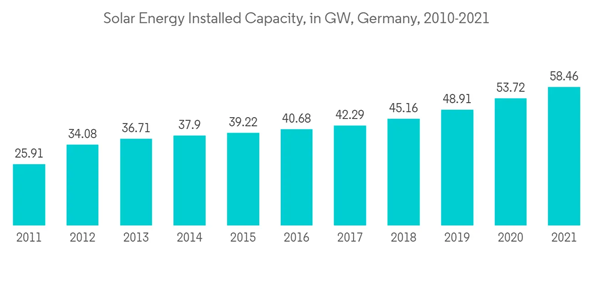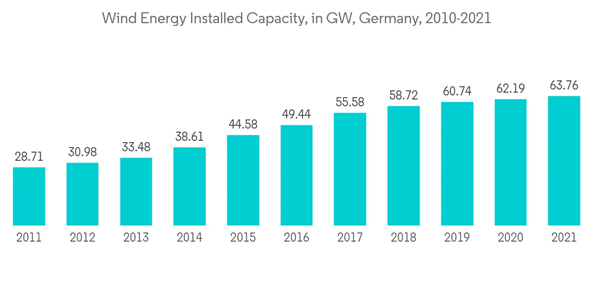The market was negatively impacted by the outbreak of COVID-19 due to regional lockdowns and delays in projects. However, the market rebounded in 2021.
Key Highlights
- Over the medium term, factors such as the increasing share of renewables in the electricity generation mix, a decline in the cost of storage batteries and solar photovoltaic panels, supportive government policies like low-interest rates on loans, and investment grants on battery systems are driving the German energy storage market.
- On the other hand, the problem of creating adequate and intelligent power grids across the country to harness and store the growing renewable energy remains a challenge, which may hinder the growth of the market.
- However, Germany is planning to install 30 GW offshore wind energy turbines by 2030, 40 GW by 2035, and 70 GW by 2045, which may require large-scale energy storage systems, thus creating a vast opportunity for companies in the coming years.
Germany Energy Storage Systems Market Trends
Battery Systems for Storage of Renewable Energy to Witness Significant Growth
- The deployment of the battery energy storage system is anticipated to increase in the coming years due to the changes in the power sector. The country has witnessed a significant increase in renewable energy installation in recent years. Lithium-ion batteries are expected to have higher demand during the forecast period.
- With the declining costs of lithium-ion batteries, the demand for batteries registered a substantial rise for residential and commercial uses, especially in the electronics and vehicle markets. Battery costs in the country have declined by more than half, and this trend is expected to continue in the coming years.
- As of March 2021, there were over 300,000 residential battery systems in the country, with a majority of these connected to solar energy.
- With more than 58.4 GW of solar capacity and more than 63.7 GW of wind energy capacity in 2021, the requirement for a storage system is expected to grow during the forecast period.
- Such development in the renewable energy sector and reduction in battery prices are expected to significantly propel the demand for battery systems to store renewable energy.
Upcoming Projects and Government Initiatives to Drive the Market
- Several public and private initiatives in the country are cooperating to develop energy storage technologies. To support the demand for storage systems and renewable energy, the federal government is making PV battery system investment highly attractive by providing unique incentives, including low-interest rates on loans and investment grants.
- The energy storage market in Germany has experienced a massive boost in recent years, majorly due to the country’s ambitious energy transition project, Energiewende. The boom in batteries and other storage technologies is expected to impact Germany’s energy transition significantly.
- Installed wind energy capacity in Germany has also witnessed significant growth in recent years, growing from 26.9 GW in 2010 to 63.7 GW in 2021.
- In October 2022, Fluence Energy and TransnetBW announced plans to develop a 250 MW battery energy storage (BES) as a transmission project in Germany. The Netzbooster project is expected to be completed in 2025.
- Such developments and government initiatives are likely to boost the demand for energy storage in the country during the forecast period.
Germany Energy Storage Systems Market Competitor Analysis
The German energy storage market is partially consolidated. Some of the major companies include (in no particular order) Enel SpA, Renewable Energy Systems Ltd, STEAG GmbH, and Fraunhofer-Gesellschaf, and Redt Energy PLC.Additional benefits of purchasing the report:
- The market estimate (ME) sheet in Excel format
- 3 months of analyst support
This product will be delivered within 2 business days.
Table of Contents
Companies Mentioned (Partial List)
A selection of companies mentioned in this report includes, but is not limited to:
- Enel SpA
- Renewable Energy Systems Ltd
- STEAG GmbH
- Fraunhofer-Gesellschaf
- Redt Energy PLC
- Sungrow Power Supply Co. Ltd
- Fluence Energy Inc.
- RWE AG
Methodology

LOADING...










